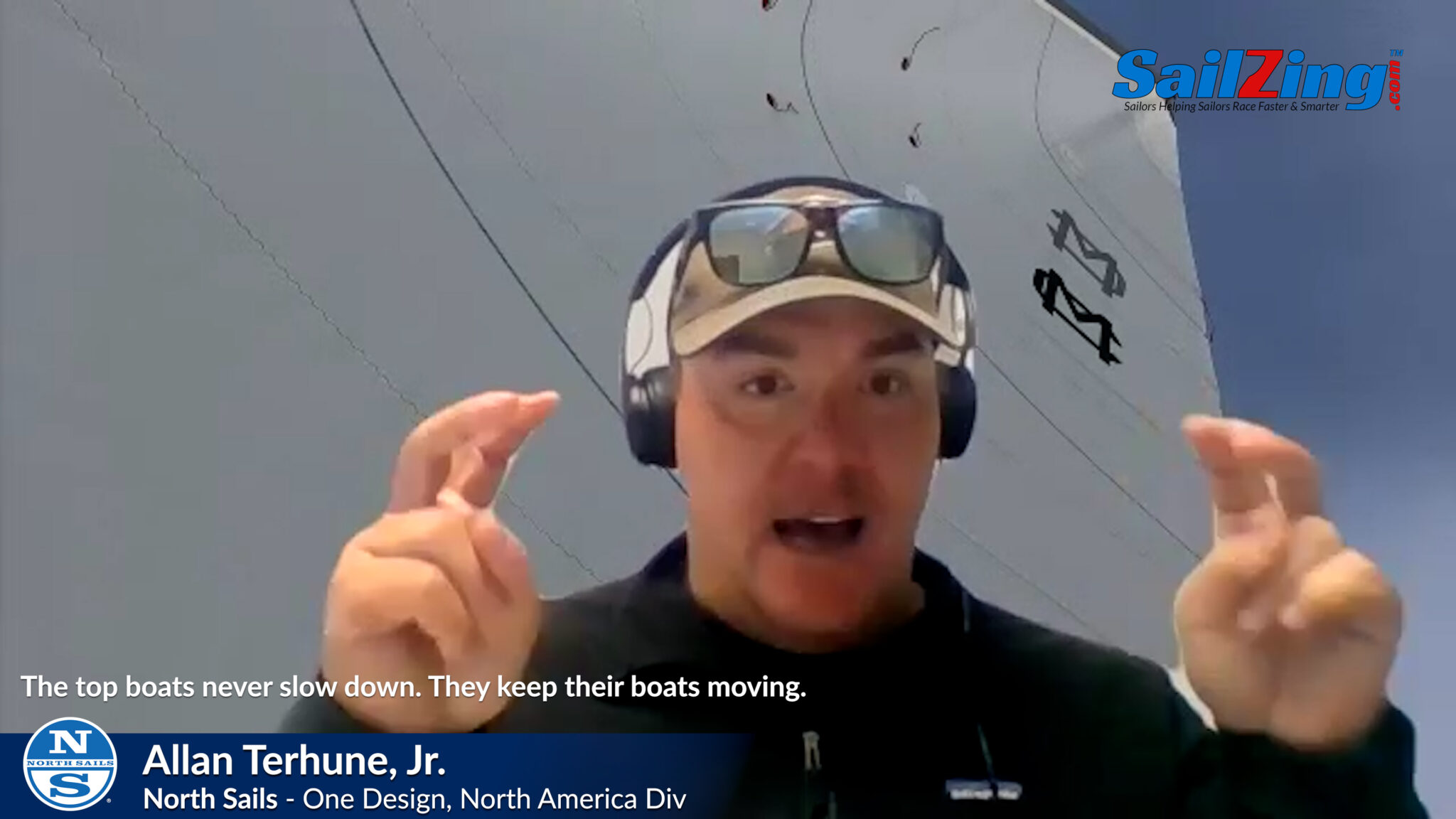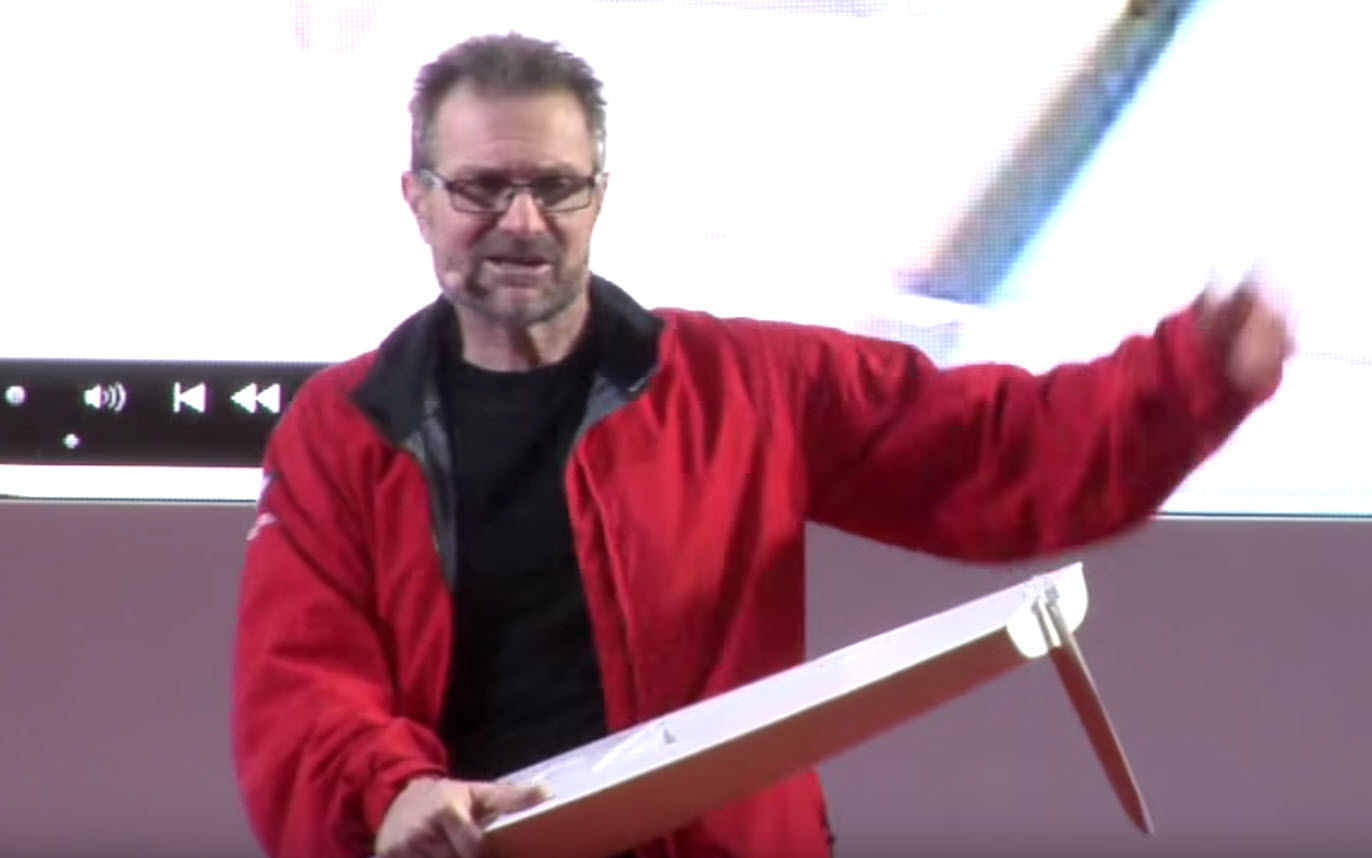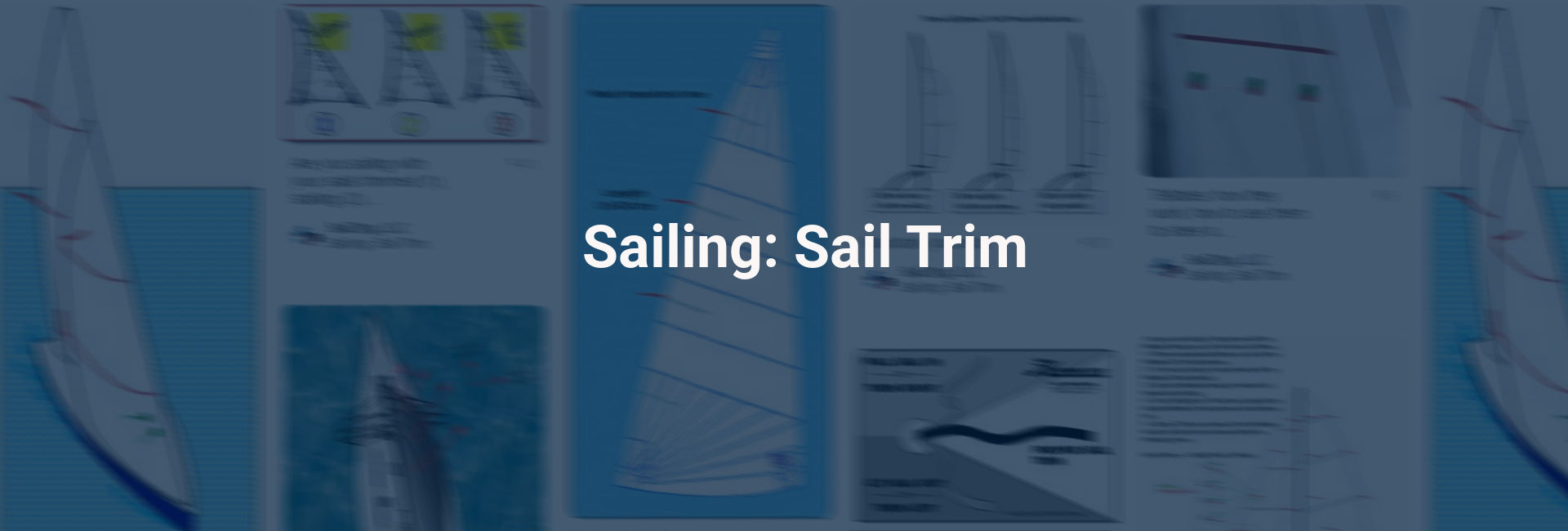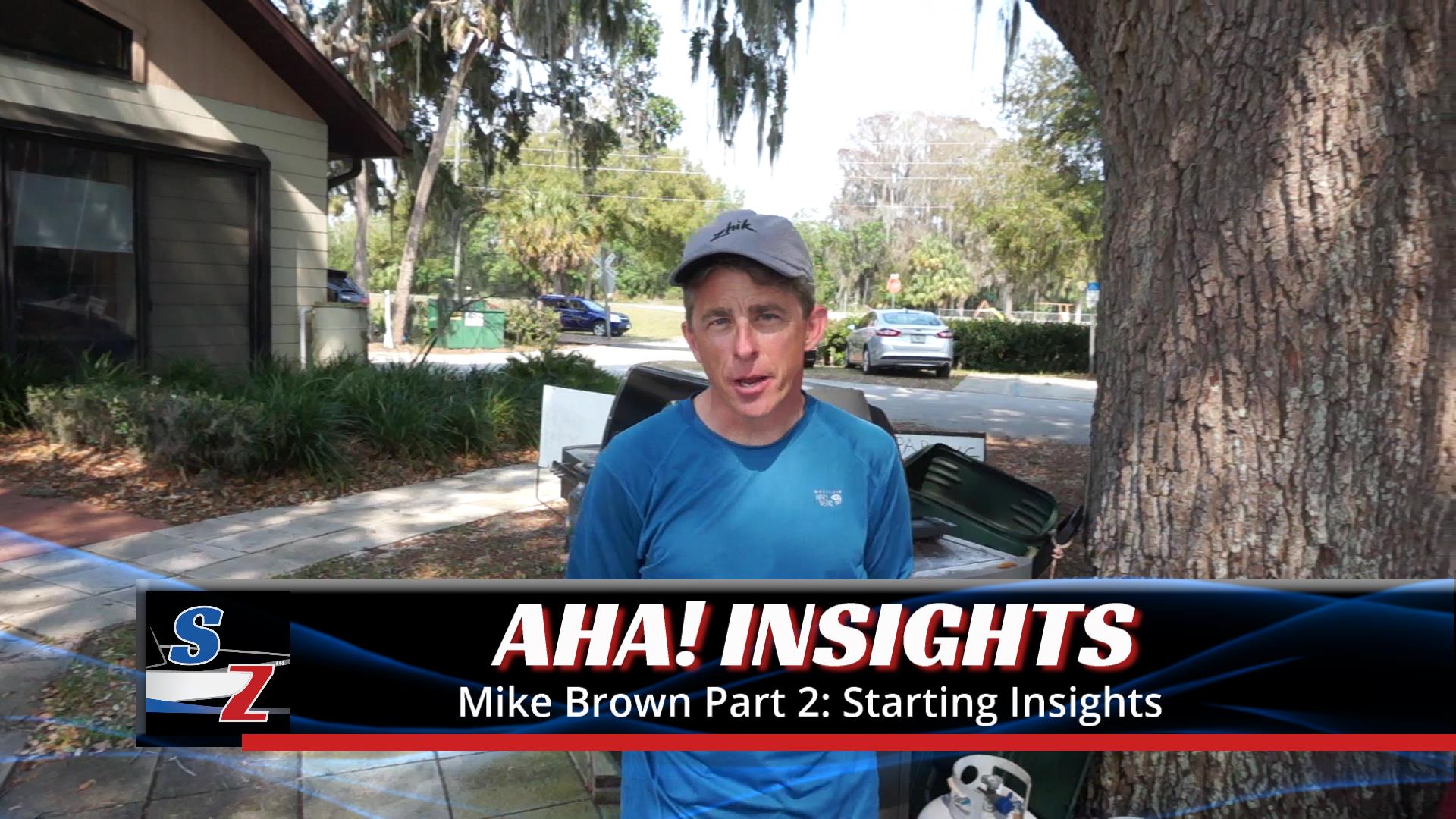This is Part 2 of a 2-part series with Allan Terhune, Jr., North Sails – Manager One Design North America Division. He shared ideas about boat handling, why the leaders appear faster, the importance of rounding the windward marks well and more at the 2023 MC Scow Train Wreck regatta at Lake Eustis, FL. In Part 1, he talked about Starting.
The event was hosted by the Lake Eustis Sailing Club and is part of a yearly, three regatta “Midwinter Series” held there.
Windward Marks
Big gains are made in my opinion…this is one thing Andy does really well…when you come off the windward mark…almost say full plane, but acceleration towards the offset and then getting the boat so when you get to the offset you can either turn down, if you need to be in a low lane, or if you’re going to stay high, have the turn done appropriately so you can protect yourself and kind of extend off the jibe mark. You see a lot of folks struggle with getting off that offset and there’s a big gain or loss to be made there.
Allan
Rounding Tips
- Roundings should be arcs, not abrupt, sharp turns.
- Keep sail in a bit as you bear off. Many ease the sail too much right away.
- Pull the board up some before offset to facilitate turning down without “tripping” over the board.
- This is where a lot of people lose boats – not only right away, but also lose positioning opportunity.
You lose a lot of positioning opportunities because then also someone turns down inside of you or you turn really too hard and then the guy behind you kind of jumps your breeze and you can’t get back to them. It’s a pretty critical situation because the reality of this, you may not lose them all right then but the whole plan for the whole leg can get messed up right at that instant.
The way I look at mark roundings, it’s like another start in the race. You’ve got to be able to execute that turn perfectly. You can take your break 30 seconds after the mark, if you need to, but you can’t do it at the mark. It is a critical execution of the turn and getting out of there. It’s the same thing at the gate marks. You have to do those better, especially the first windward mark and the first gate, because the boats are more compressed. If the second mark, maybe it’s not as big a deal, but the first one especially you have to make sure you make those turns correctly. That’s one of the big differences between getting a top 10 or a 25 because if you do it wrong and you have to jibe or you get run over. That’s the pack that kind of swallows you up.
Allan
SZ: Lots of losses seem to happen coming into marks and leaving marks.
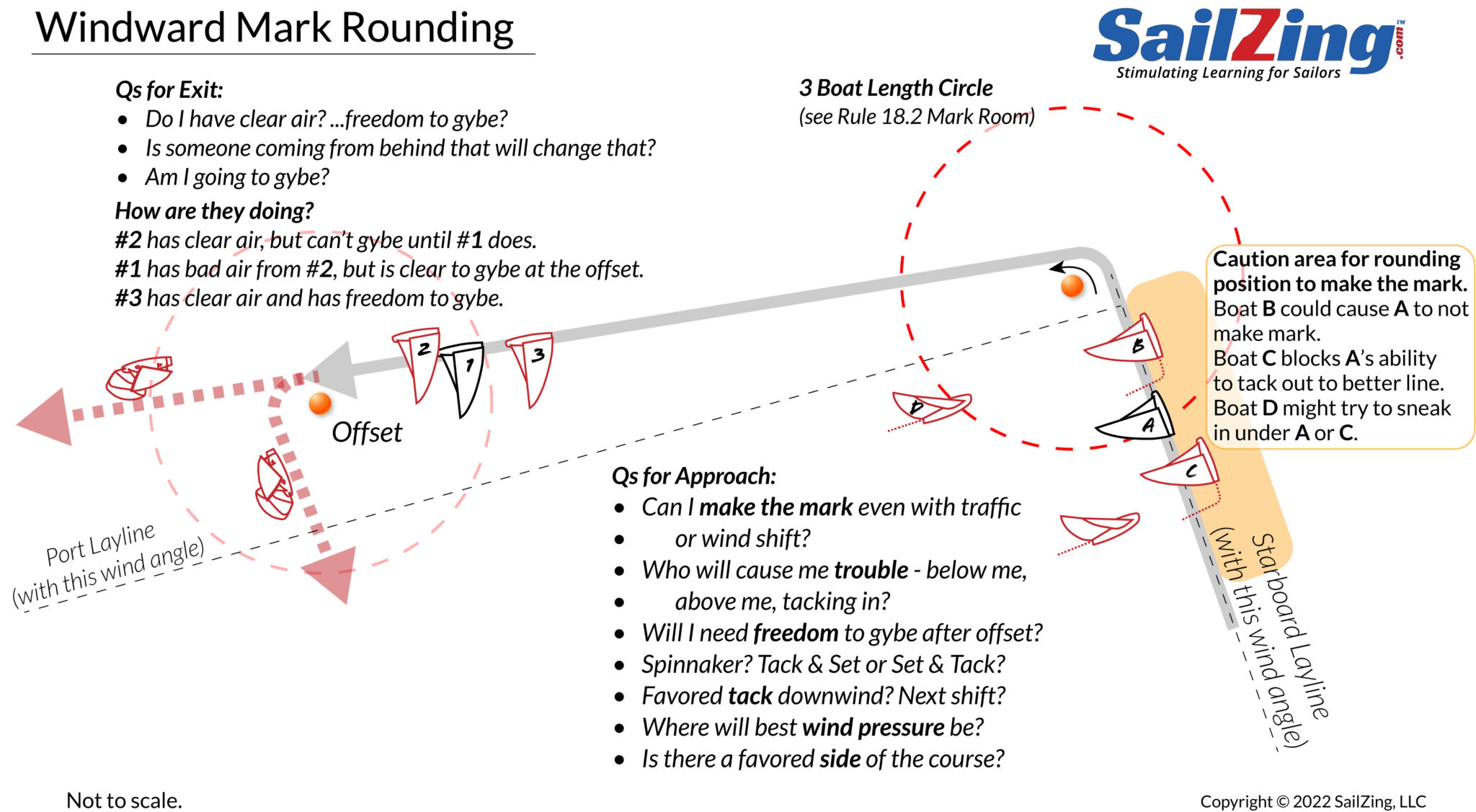
When the breeze is up, it gets harder to turn the boat down at the mark, if you don’t lift your board a bit. Allan lifts his leeboard half way as he rounds and almost all the way up once he’s on his lines downwind.
Downwind Leg
Identify which jibe is the longest and get on that as quickly as possible.
MC Scows Like Space
The other thing that I think is critical, and I’ve learned quite a bit, is these boats (MC Scows) don’t like to be next to each other. So if you want to go fast downwind you have to find your own space. Even if it means kind of going the wrong way a little bit to get your own space and then be able to go. The boats sail so much better in space. I mean, the speed differences are just drastic. So I think finding your own little piece of land, which isn’t always easy, is pretty important.
Allan
SZ: I always try to avoid one-on-one competitions downwind. I try to focus on the big picture. Some frustrated sailors can get fixated on beating just one boat and lose many.
Allan: Never. Sometimes you have to give up one to beat ten or something like that it’s you know it’s making the decisions there of what’s the most critical.
Top Boats Almost Never Slow Down
SZ: What are some things that Andy Burdick did (event winner) to edge you out?
If you watch Andy sail, he gets off the (starting) line really well all the time. It’s pretty rare you see him have a bad start. If you look at the top boats in that regatta…myself, Matt Fisher, Bill Draheim, you know, all the top boats… The one thing I think that sets the boats apart – I don’t think it’s that they’re faster. I wouldn’t say Andy is faster, but the one thing he doesn’t do is he doesn’t slow down. So the boats end up being “faster” because they don’t have the moments where they slow up. The top boats just stay at speed all the time. They’re not transitioning, huge transitions. Maybe you get a tenth or two-tenth knots slower and then you get the speed back up. Whereas someone who’s not quite as quick goes down four-tenths of a knot and then they have to build their speed back up. You see that the difference is that the slower boats fall back because they slow down and then speed back up and then slow down and speed back up. Whereas the top boats, if you watch, they are at top speed. They slow down a little bit and then they’re right back to top speed again. I think that’s kind of the big difference. I wouldn’t say if you line any of us up next to a mid-fleet boat are we “faster”? Not necessarily. I think the difference is (they) maintain top speed longer. If you watch Andy sail, he never slows down. Ever. It’s remarkable. So that’s kind of the difference.
Allan
Related Content
Mike Schroff on sailing the Melges 15 fast and not slowing down.
SZ: We’ve spoken to Andy in the past about how he anticipates pressure changes and adjusts proactively. That helps him to avoid slowing down.
Allan: The boat accelerates and decelerates pretty drastically. The boat has a big range of speed. On my J22 or my J70, if you decelerate or accelerate the range of speed difference is not that big. Whereas in an MC, you get a puff, you could be going a knot faster than somebody else. So it’s maintaining those speeds, I think, is the difference between a top-top boat and an average boat. <> They’re all trying to do the same thing, right, which is keep the boat on its “feet”. Keep the boat on a heel angle. Keep the boat at speed.
SZ: We’ve seen really skilled sailors with technique that helps them to be smooth. One example is they move their tiller hand and mainsheet hands in opposition to each other. From the high side, heading up? – Tiller away from you, while mainsheet hand comes towards you. Bearing off? – Tiller towards you, while mainsheet hand goes away from you (eases). This make for a fluid and simultaneous movement.
Common Mistakes
The big one to me is still the starting situation, because it seems like everyone just clumps up at the boat end. I don’t know why it makes everyone feel comfortable, but you know to me it’s getting space and just sailing your own race is more important than being all clumped up there. I think that’s one thing.
The second one is, as it gets breezier, finding ways to depower the boat and just pulling the controls on and doing things. You see a lot of boats out there, they’re under-Vanged and they’re under-Outhauled and under Cunningham all the time. I think it was day two, it was pretty breezy, if I recall correctly. I mean you look, everything’s on almost as hard as they can pull it. Then you see boats in the middle or the back that are struggling and everything’s off. Then they’re like “Oh, you couldn’t keep the boat from tipping over.” Well, you’ve got to pull Vang on. You got to pull the Outhaul on. So I think a little bit of it is just the basic…keeping your controls in line. I think some of it too is a little bit of not being afraid to try things. The one thing about the boat is it tells you when it’s unhappy pretty quickly. Right? I mean the puff hits and it’s rounding up or the boat is overpowered, it’s tipping over. I mean it’s telling you it’s not right, so I think the real issue is just taking that diagnosis and trying to figure out how to help it out.
Allan
SZ: On Starts – A lot of times try people think “This is the favored end. I’ve got to be right at the favored end.” Sometimes the favored end is the next spot down that’s open.
Allan: My number one thing is the favored half is what I call it and then finding the most low density place I can find. Because there’s nothing worse than being stuck between two boats. You just got to be able to go and just do your thing. So, if you give up 10 spots on the line to have room, it’s totally worth it…being on the front line.
SZ: Being in the front line, with fresh air. Being second row or even being slightly behind the boat to windward is…it’s exponential how far back you can go.
Allan: Brutal. The problem is, for a lot of scow racing, it’s lake sailing. So there’s usually pretty big shifts. So you either got to be at one tack or the other pretty quickly. So if you’re not in the front group and can’t do that, it’s really tough. Because then you’re sailing in bad air on the wrong tack and all of a sudden you’re in the back half of the fleet right away. It’s a tough road to go from that.
Leeboard Angles
People were asking about how critical the leeboard angles are. I kind of think it is. Know your all-purpose setting where max down is. Just not being afraid that, when you start getting overpowered or it’s getting windier, to pull the board up that little bit. You can almost sit there, hold the tiller, sail slowly, pull the board line up and you can feel the boat just go. That’s kind of your free spot. I think a lot of folks resist. I know when I started sailing MC, I was very resistant to doing it, and it made a huge difference.
Right before the Inlands (ILYA Championships) in Okoboji, we did a good training session with Chris Kubicek and Al Haeger and JP coaching (John Porter / LBYC). It was great. We’re going upwind.Me: “Man. I feel pretty good.”
JP: “You’ve got to pull the board up.”
Me: “You’re nuts.”
JP: “I’m telling you. I could see the wake on your rudder. The boat’s not going as fast you can go. You got to pull the board up.”
I resisted.
JP: “Just do it. Try it and if it doesn’t work you can go back. It’s a practice session, but just trust me on this. You got to do it.”
We’re going upwind and I’m all lined up and I feel like I’m going pretty good and he’s like…
JP: “Do it.”.
I pulled the board up and the boat instantly, like…it was a different boat. So, to me, that I think is the biggest. On days like we had on (Lake) Eustis, just getting the board up a little bit. It’s not a lot. I mean, we’re talking half an inch to an inch, max. It makes all the difference.
Allan
SZ: Indicator one that you may need to raise your boards is you have excessive windward helm.
Allan: Yep. As soon as the helm goes away, you’re good to go.
SZ: Slightly more than neutral, so you retain some feel.
Allan: Right. You want a little windward helm, but not much.
SZ: Thanks for sharing your insights!

